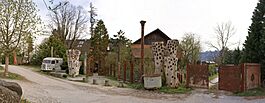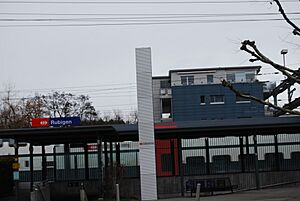Rubigen facts for kids
Quick facts for kids
Rubigen
|
||
|---|---|---|
 |
||
|
||
| Country | Switzerland | |
| Canton | Bern | |
| District | Bern-Mittelland | |
| Area | ||
| • Total | 6.92 km2 (2.67 sq mi) | |
| Elevation | 549 m (1,801 ft) | |
| Population
(Dec 2020 )
|
||
| • Total | 2,892 | |
| • Density | 417.9/km2 (1,082.4/sq mi) | |
| Postal code |
3113
|
|
| Surrounded by | Allmendingen, Belp, Münsingen, Trimstein, Worb | |
Rubigen is a town in Switzerland. It is located in the Bern-Mittelland area, which is part of the canton of Bern.
Contents
Rubigen's History
Rubigen was first mentioned way back in 1267. Back then, it was called Rubingen.
Early Settlements
People have lived in the Rubigen area for a very long time. Scientists have found old tools and items from the neolithic (New Stone Age) and Bronze Age. They also found tombs from the La Tene culture, which was an ancient Celtic group.
Later, during the Roman times, a fountain was built here. An early medieval cemetery has also been discovered.
Medieval Times and Beyond
During the Middle Ages, Rubigen was part of a larger area called the Herrschaft of Münsingen. The rulers of Münsingen built a fort near Rubigen around 1278. We don't know much about this fort, but it was destroyed in 1798.
In the 1400s, Rubigen became more independent. In the 1500s, it became part of the city of Bern. Rich families from Bern, called patricians, built their summer homes in Rubigen because it was close to the city.
Joining Together
The small village of Beitenwil was first mentioned in 1328. It was owned by a monastery called Fraubrunnen Abbey. In 1473, it became part of the Herrschaft of Worb and was joined with Trimstein.
In 1834, three school districts – Rubigen, Allmendingen, and Trimstein – came together. They formed the political municipality of Rubigen. These three areas stayed united until 1993.
Controlling the River
The Aare River often flooded the roads and fields around Rubigen. This caused a lot of damage. To fix this, big projects called the Jura water correction were done between 1824 and 1831. These projects finally helped control the river. This allowed the villages to build more roads and buildings.
The Hunzigen bridge was built in 1836. It replaced several ferries that people used to cross the river. Even with better roads and a bridge, the villages stayed small and mostly rural.
Modern Growth
A train station opened in Rubigen in 1859. It was on the train line between Bern and Thun. But even this didn't make the town grow much at first.
Rubigen's population only started to grow in the 1960s. The A6 motorway (a big highway) was finished in 1973. This encouraged even more people to move there. Today, many people who live in Rubigen travel to nearby cities for work.
Rubigen's Geography
Rubigen covers an area of about 7 square kilometers (2.7 square miles).
Land Use
Most of Rubigen's land is used for farming. About 54% of the area is farmland. Forests cover about 20% of the land. Buildings and roads make up about 21% of the area. Rivers and lakes cover about 3%, and a small part is unproductive land.
In the farming areas, about 45% is used for growing crops. Pastures for animals make up about 7%. A small part is used for orchards or vineyards.
Location and Parts of Town
Rubigen is located in the Aaretal, which means the Aare Valley. The municipality includes the main village of Rubigen. It also has smaller villages called hamlets, like Beitenwil, Kleinhöchstetten, and Hunzigen. There are also many individual farmhouses scattered around.
Until 1992, Rubigen also included the areas of Allmendingen and Trimstein. However, these two became their own independent towns in 1993.
In 2010, Rubigen joined a new administrative district. This new district is called Verwaltungskreis Bern-Mittelland.
Rubigen's Coat of Arms
The coat of arms for Rubigen is described as: "Sable a Pale and a chief Or and on the last three Roses Gules barbed and seeded proper."
This means it has a black background. There is a gold stripe down the middle and a gold band across the top. On the gold band, there are three red roses with green leaves and seeds.
People of Rubigen (Demographics)
Rubigen has a population of about 2,862 people (as of December 2011).
Population Changes
About 7.5% of the people living in Rubigen are foreign nationals. Over the last ten years (2001-2011), the population has stayed mostly the same. Some people moved away, but new births balanced that out.
Languages Spoken
Most people in Rubigen speak German. About 91.8% of the population speaks German as their main language. French is the second most common language, spoken by about 1.6% of people. Italian is third, spoken by about 1.3%.
Where People Come From
About 17% of the people in Rubigen were born there. More than half (51.4%) were born in the same canton (Bern). About 17.5% were born elsewhere in Switzerland. About 10.7% were born outside of Switzerland.
Age Groups
In Rubigen, children and teenagers (ages 0-19) make up about 20% of the population. Adults (ages 20-64) make up about 64%. Seniors (over 64 years old) make up about 15.7%.
Family Life
In 2000, about 1,077 people in Rubigen were single and had never been married. About 1,183 people were married. There were also 119 widows or widowers and 123 divorced people.
Housing
In 2010, there were 357 homes where only one person lived. There were 55 homes with five or more people. Most apartments (92.1%) were lived in all the time. A small number were used only part of the year or were empty.
Population Over Time
The chart below shows how Rubigen's population has changed over many years:

Important Sights in Rubigen
The entire small village of Kleinhöchstetten is a special place. It is listed as part of the Inventory of Swiss Heritage Sites. This means it's an important historical and cultural area.
Rubigen's Economy (Jobs and Work)
In 2011, Rubigen had a low unemployment rate of 1.38%. This means most people who wanted jobs had them.
Types of Jobs
In 2008, there were 923 people working in Rubigen.
- Primary Sector: About 63 people worked in farming and related businesses. There were 21 businesses in this area.
- Secondary Sector: About 375 people worked in manufacturing and construction. There were 25 businesses in this area.
- Tertiary Sector: About 485 people worked in services, like shops, offices, and healthcare. There were 71 businesses in this area.
About 45% of the workers in Rubigen were women.
Full-Time Jobs
In 2008, there were 752 full-time equivalent jobs in Rubigen.
- Farming and Fishing: 42 jobs were in agriculture and fishing.
- Manufacturing and Construction: 358 jobs were in factories (manufacturing), mining, and building (construction).
- Service Jobs: 352 jobs were in services. This included jobs in:
- Shops and car repair (25.9%)
- Moving and storing goods (1.1%)
- Hotels and restaurants (4.3%)
- Information industry (2.3%)
- Insurance and finance (2.8%)
- Technical and scientific jobs (6.3%)
- Education (6.0%)
- Healthcare (40.3%)
Commuting
In 2000, 494 workers came into Rubigen for their jobs. However, 1,129 workers left Rubigen to work in other towns. This means more people leave Rubigen for work than come in.
About 31.9% of workers used public transportation to get to work. About 45.1% used a private car.
Religion in Rubigen
Based on the 2000 census:
- Most people (67.8%) belonged to the Swiss Reformed Church (a Protestant church).
- About 13.2% were Roman Catholic.
- Smaller groups included Orthodox Christians (0.8%), other Christian churches (7.99%), and Islamic people (1.16%).
- A small number of people were Buddhist or Hindu.
- About 9.39% of the population did not belong to any church.
Education in Rubigen
In Rubigen, many people have a good education. About 44.4% of adults have finished high school. About 16.4% have gone on to higher education, like a university or a specialized college.
School System
The Canton of Bern has a specific school system:
- One year of optional Kindergarten.
- Six years of Primary school.
- Three years of required lower Secondary school. Students are grouped by their abilities.
- After secondary school, students can continue their education or start an apprenticeship (learning a trade on the job).
Students in Rubigen
During the 2011–12 school year, 215 students attended classes in Rubigen.
- There were 4 kindergarten classes with 65 students.
- There were 8 primary classes with 150 students.
- Some students (about 9-13%) were not Swiss citizens or had a different first language than the classroom language.
In 2000, only 4 students came from other towns to study in Rubigen. However, 153 students from Rubigen went to schools outside the municipality.
Local Library
Rubigen has its own library called the Schul- und Gemeindebibliothek Rubigen. In 2008, the library had almost 8,000 books and other items. It loaned out over 27,000 items that year. The library was open 153 days a year, for about 5.5 hours per week.
See also
 In Spanish: Rubigen para niños
In Spanish: Rubigen para niños







